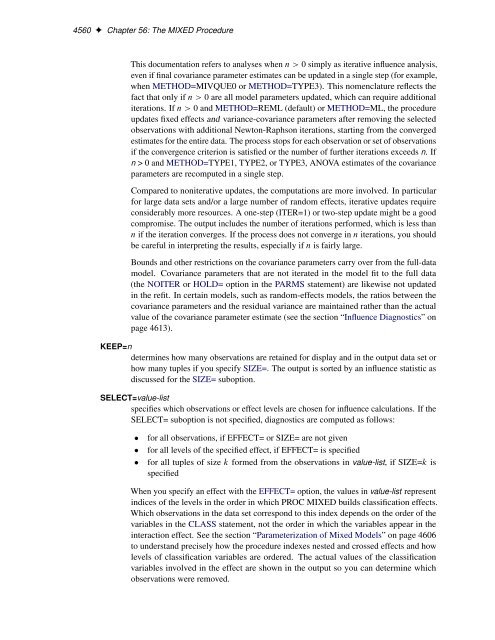SAS/STAT 922 User's Guide: The MIXED Procedure (Book Excerpt)
SAS/STAT 922 User's Guide: The MIXED Procedure (Book Excerpt)
SAS/STAT 922 User's Guide: The MIXED Procedure (Book Excerpt)
Create successful ePaper yourself
Turn your PDF publications into a flip-book with our unique Google optimized e-Paper software.
4560 ✦ Chapter 56: <strong>The</strong> <strong>MIXED</strong> <strong>Procedure</strong><br />
This documentation refers to analyses when n > 0 simply as iterative influence analysis,<br />
even if final covariance parameter estimates can be updated in a single step (for example,<br />
when METHOD=MIVQUE0 or METHOD=TYPE3). This nomenclature reflects the<br />
fact that only if n > 0 are all model parameters updated, which can require additional<br />
iterations. If n > 0 and METHOD=REML (default) or METHOD=ML, the procedure<br />
updates fixed effects and variance-covariance parameters after removing the selected<br />
observations with additional Newton-Raphson iterations, starting from the converged<br />
estimates for the entire data. <strong>The</strong> process stops for each observation or set of observations<br />
if the convergence criterion is satisfied or the number of further iterations exceeds n. If<br />
n > 0 and METHOD=TYPE1, TYPE2, or TYPE3, ANOVA estimates of the covariance<br />
parameters are recomputed in a single step.<br />
Compared to noniterative updates, the computations are more involved. In particular<br />
for large data sets and/or a large number of random effects, iterative updates require<br />
considerably more resources. A one-step (ITER=1) or two-step update might be a good<br />
compromise. <strong>The</strong> output includes the number of iterations performed, which is less than<br />
n if the iteration converges. If the process does not converge in n iterations, you should<br />
be careful in interpreting the results, especially if n is fairly large.<br />
Bounds and other restrictions on the covariance parameters carry over from the full-data<br />
model. Covariance parameters that are not iterated in the model fit to the full data<br />
(the NOITER or HOLD= option in the PARMS statement) are likewise not updated<br />
in the refit. In certain models, such as random-effects models, the ratios between the<br />
covariance parameters and the residual variance are maintained rather than the actual<br />
value of the covariance parameter estimate (see the section “Influence Diagnostics” on<br />
page 4613).<br />
KEEP=n<br />
determines how many observations are retained for display and in the output data set or<br />
how many tuples if you specify SIZE=. <strong>The</strong> output is sorted by an influence statistic as<br />
discussed for the SIZE= suboption.<br />
SELECT=value-list<br />
specifies which observations or effect levels are chosen for influence calculations. If the<br />
SELECT= suboption is not specified, diagnostics are computed as follows:<br />
for all observations, if EFFECT= or SIZE= are not given<br />
for all levels of the specified effect, if EFFECT= is specified<br />
for all tuples of size k formed from the observations in value-list, if SIZE=k is<br />
specified<br />
When you specify an effect with the EFFECT= option, the values in value-list represent<br />
indices of the levels in the order in which PROC <strong>MIXED</strong> builds classification effects.<br />
Which observations in the data set correspond to this index depends on the order of the<br />
variables in the CLASS statement, not the order in which the variables appear in the<br />
interaction effect. See the section “Parameterization of Mixed Models” on page 4606<br />
to understand precisely how the procedure indexes nested and crossed effects and how<br />
levels of classification variables are ordered. <strong>The</strong> actual values of the classification<br />
variables involved in the effect are shown in the output so you can determine which<br />
observations were removed.

















